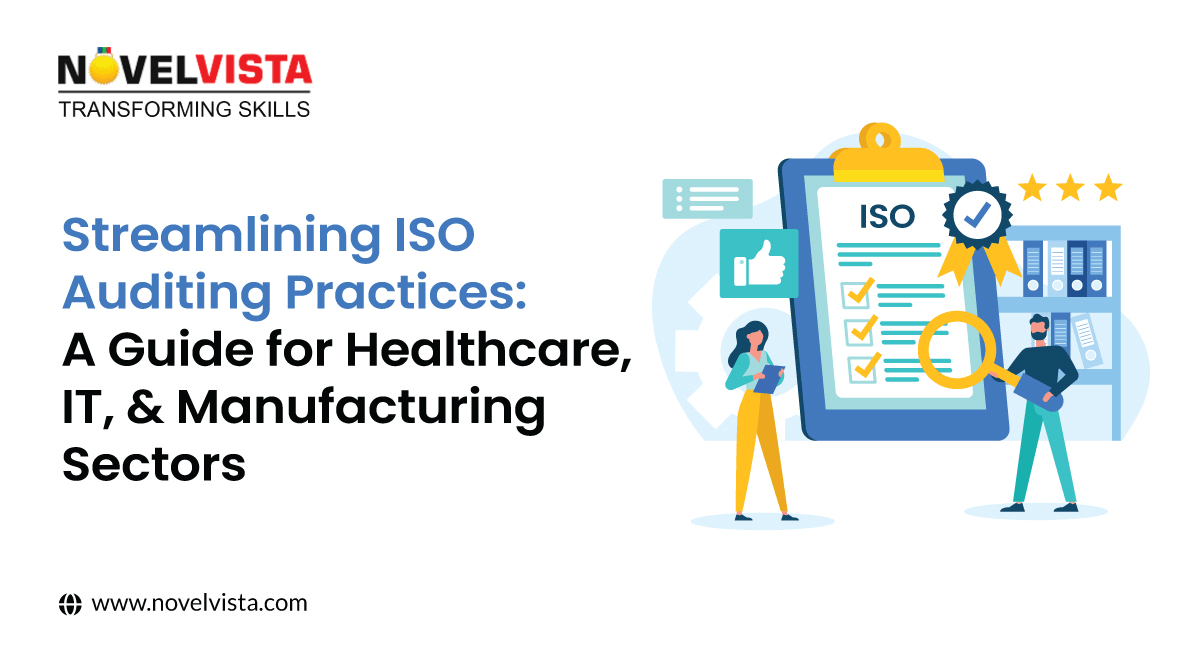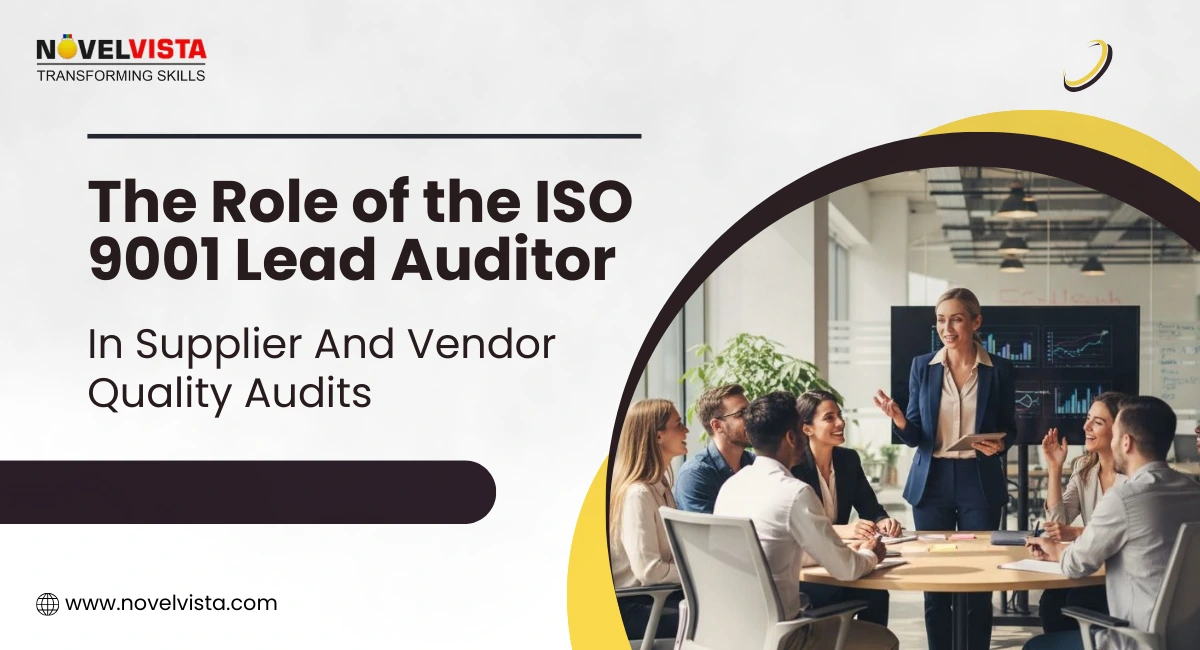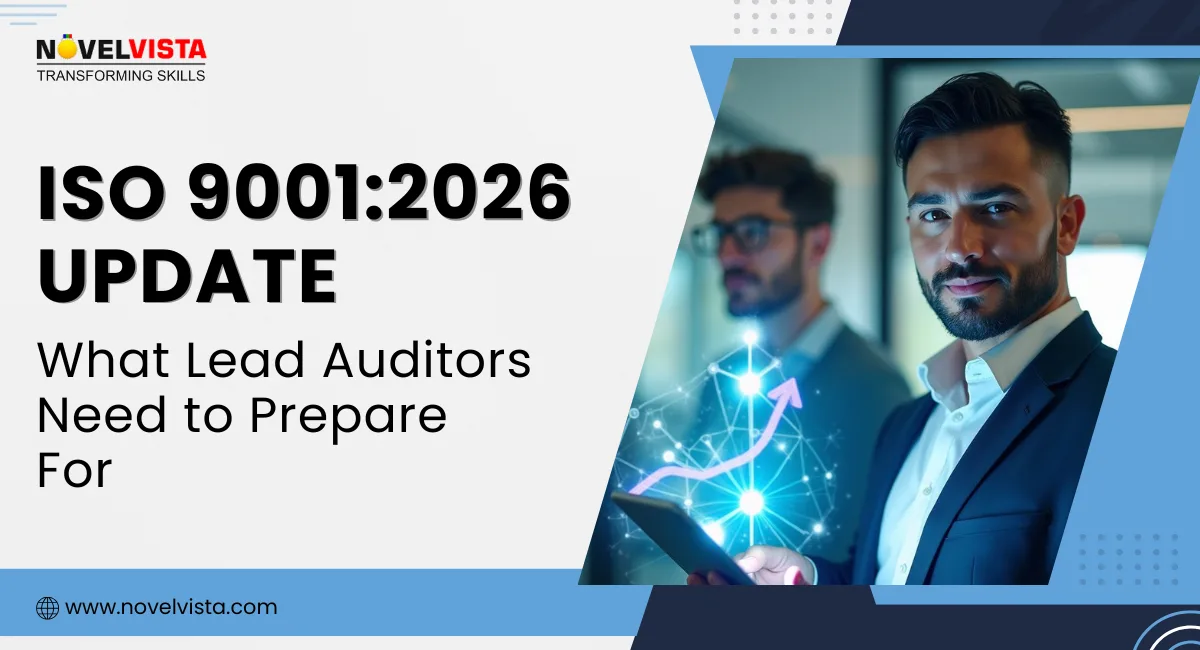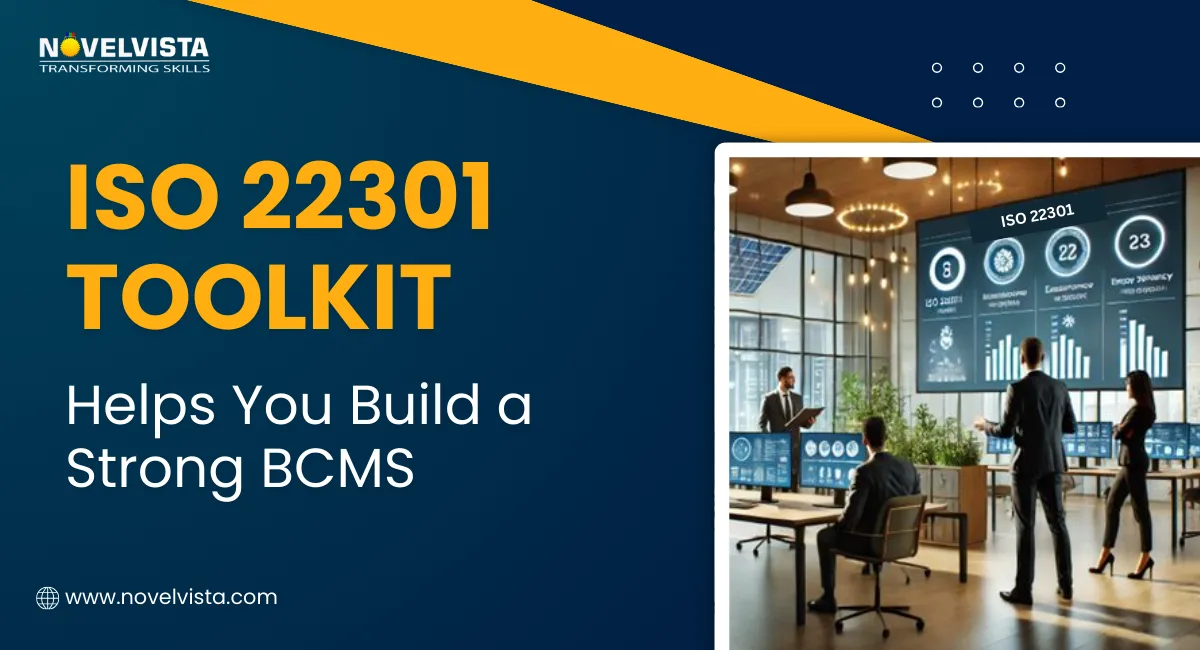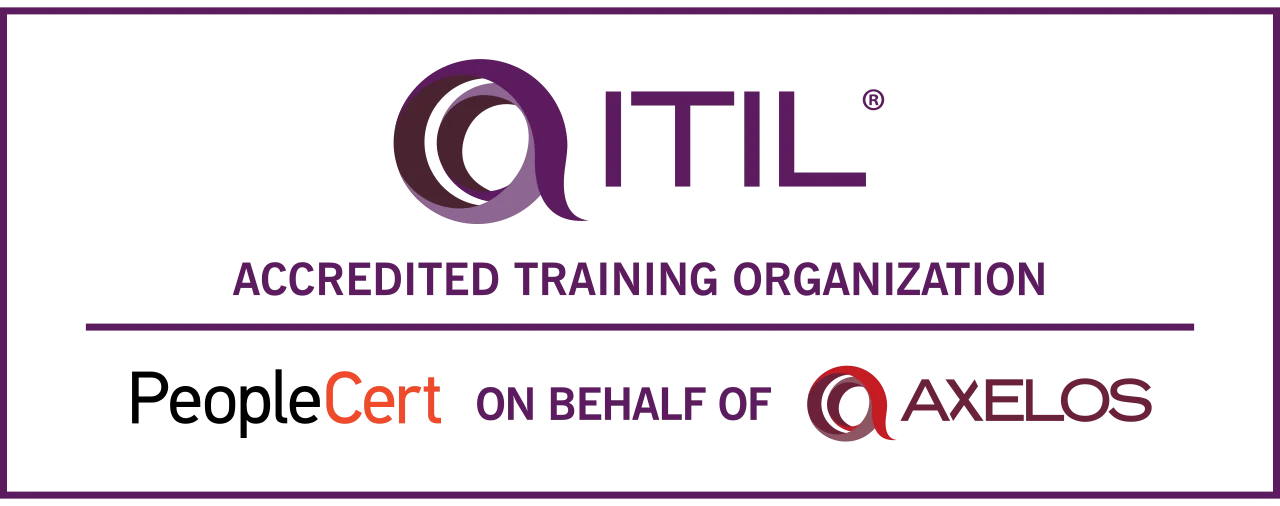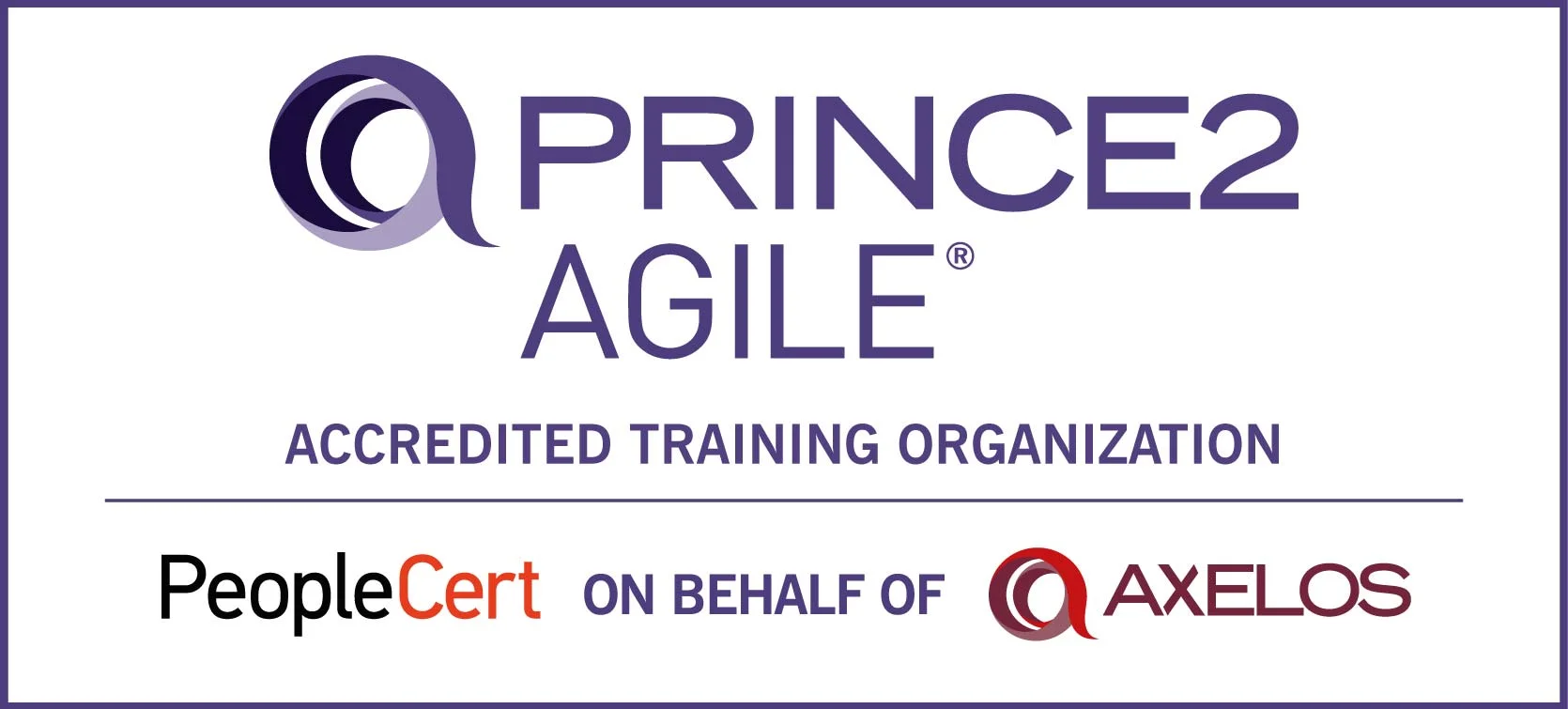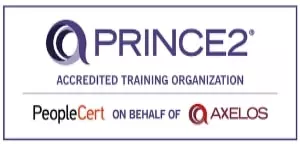- The Importance of ISO Auditing in Healthcare, IT, and Manufacturing Sectors
- ISO Auditing Standards and Certification
- Types of ISO Audits
- Step-by-Step Guide to the ISO Audit Process
- ISO Auditing Process and Procedures
- Industry-Specific ISO Audit Insights
- Best Practices for ISO Auditing in Healthcare, IT, and Manufacturing Sectors
- Common Challenges in ISO Auditing
- Strategies for Streamlining ISO Auditing Practices
- Technology Solutions for Efficient ISO Auditing
- Training and Education for ISO Auditors
- Conclusion
"Quality is not an act, it is a habit. Continuous improvement is the key to staying competitive."
Globalization is heating up industry competition, pushing businesses to adopt international standards to get ahead. Healthcare, tech, and manufacturing firms are finding ISO (International Organization for Standardization) audits helpful. They build credibility, ensure rules are followed and promote ongoing improvements. Still, simplifying the ISO audit process is tough due to all the detailed rules involved. This all-in-one guide digs into why ISO audits matter for quality control in the healthcare, tech, and manufacturing sectors. It takes apart the tricky ISO 27001 certification journey, pinpoints usual hurdles that companies meet, and shares smart moves to make audit practices more efficient. Medical centers, production facilities, and tech companies need to understand ISO audit methods now. It's not only valuable, it's critical. Businesses need to excel, keep their data safe, and meet high standards. This guide can help. It gives quality assurance teams and operations the knowledge to promote compliance, use technology for better audits, and meet global supply chain standards. ISO audit methods can improve things. Better healthcare? Yes. Stronger information systems? Absolutely. Top-notch manufactured products? Indeed.
The Importance of ISO Auditing in Healthcare, IT, and Manufacturing Sectors
ISO audits are key for healthcare organizations, tech firms, and manufacturers. They help to tidy up procedures, boost performance, and earn worldwide acclaim.In the health sector, ISO validation shows that a hospital or clinic is dedicated to giving excellent patient care. It proves they're serious about reducing mistakes and risks.Audits that examine clinical rules, machine upkeep, and record management can change the way care is given. They also boost public confidence.Let's takeISO 9001audits as an example. They enhance procedures in vital areas like infection prevention, drug dispensing, and continuity of care during staff shift changes.In the same vein, ISO 13485 audits allow for corrections and improved safety in the formation of medical machines.Tech companies count a lot onISO 27001information security audits. These audits shield intellectual property, ensure data credibility, guard privacy, and keep cyber threats at bay.Discovering access control gaps, outdated patches, or unauthorized changes through audits, prompts swift rectification. Cloud services like AWS promote ISO 27001 compliance, assuring clients of their assets, and application security.In manufacturing, ISO quality checks are crucial. They enhance production systems, reduce product flaws, and avert recalls.Audit outcomes that expose inferior materials, calibration discrepancies, or weak process controls stimulate improvement. Software manufacturers achieve ISO 9001 certification, guaranteeing customers stringent development, quality testing, and robust delivery protocols.So, routine ISO audits greatly assist critical organizations. They demonstrate a dedication to excellence, striving for the pinnacle.
ISO Auditing Standards and Certification
The International Organization for Standardization, or ISO, has created a plethora of rules.These rules offer a pattern for companies in different fields. They help setup and keep up topnotch quality and management systems.These standards have global recognition. They offer a structured way to attain excellent performance in operations.
Here are some commonly used ISO standards and how they are applied:
- ISO 9001 (Quality Management Systems):This rule sets out the terms for a company. It proves they can consistently offer products and services meeting customer and regulatory needs. Various sectors can apply this, like manufacturing, healthcare, and the service industry.
- ISO 13485deals with quality management for medical devices. It's unique to healthcare. The standard ensures organizations focus on the safety and effectiveness of medical devices. This includes design, production, installation, and servicing.
- ISO 14001is about environmental management systems. It offers guidelines to organizations. The aim is to reduce environmental impact. It also helps in complying with regulations and continually upgrading the environmental performance.
- ISO 27001tackles information security management systems. Great for IT and technology organizations. The standard provides requirements for maintaining and continually enhancing an information security system. It ensures the safety, integrity, and availability of sensitive information.
ISO certification is a big deal for businesses. It means they’ve gone through tough checking by third-party groups.These groups look at if the company is meeting the ISO standard's rules. Being certified shows a company’s dedication to quality, caring for the environment, and keeping information safe, among other things covered by the specific standard.The benefits of ISO certification are more than just looking good. It gives a company an edge over rivals by showing they play by the rules set out internationally. It opens doors to new markets, boosts customers' trust, and encourages ongoing betterment within the company.
Types of ISO Audits
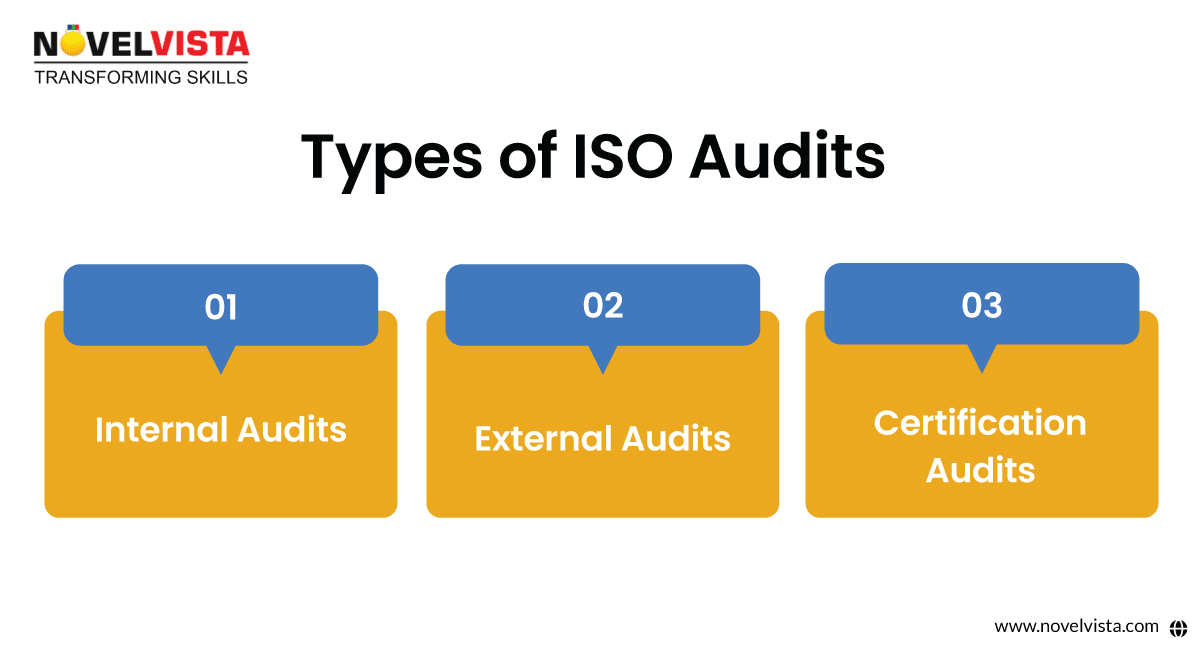 Organizations undergo different types of audits based on their goals:
Organizations undergo different types of audits based on their goals:
- Internal Audits: Performed in-house audit to check the compliance Preparedness.
- External Audits: Performed by independent auditors to verify adherence.
- Certification Audits: A final assessment that grants official ISO certification.
For businesses managing sensitive information, obtaining ISO 27001 Lead Auditor Certification is essential for upholding security compliance.
Step-by-Step Guide to the ISO Audit Process
A clear audit operation helps companies plan effectively. Here’s a structured approach:
1. Planning and Preparation
- Identify applicable standards (For Example, ISO 27001 information security).
- State goals, scope, and required resources.
- Select skilled auditors and inform stakeholders.
2. Document Review
- Analyse policies, workflows, and operational records.
- Assure documentation aligns with compliance requirements.
3. On-Site Audit (For External and Certification Audits)
- Conduct interviews and observe operational practices.
- Assess risk management strategies.
- Identify gaps and non-conformities
4. Audit Findings and Reporting
- Categorize findings and suggest corrective actions.
- Track the audit report for internal review.
5. Corrective Actions and Follow-Up
- Apply necessary improvements.
- Carry out a follow-up audit to confirm compliance.
Enrolling in ISO 9001 Lead Auditor Training and Certification is highly recommended for professionals looking to master the ISO audit process.
ISO Auditing Process and Procedures
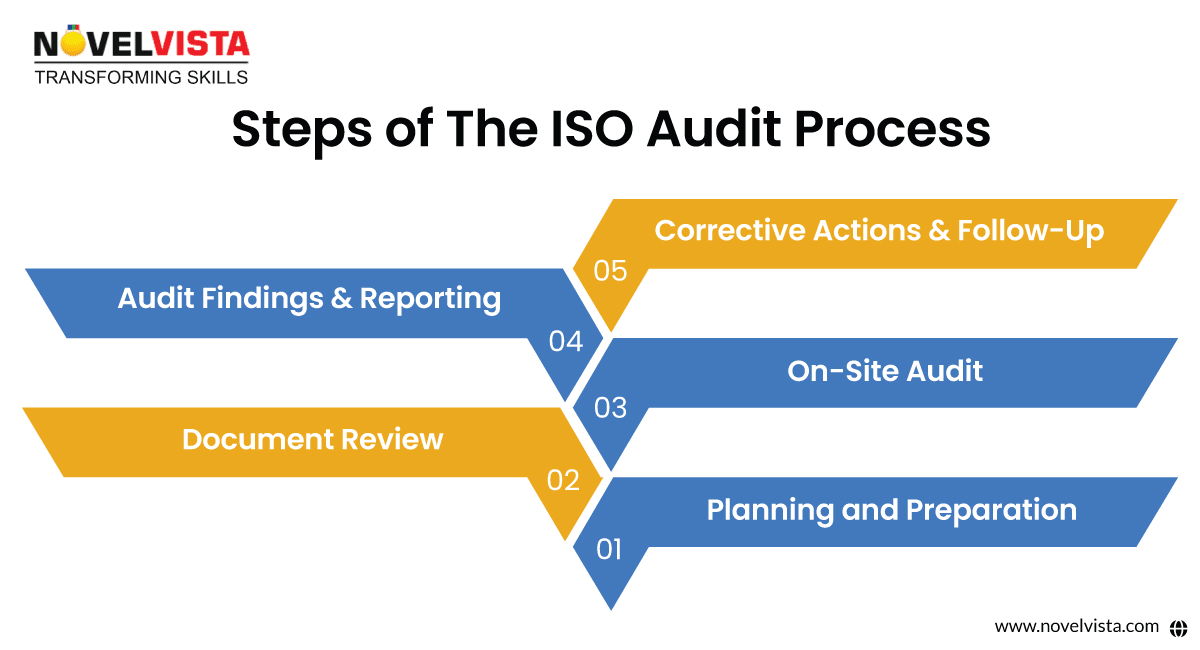
ISO audits work by following a thorough, designed technique. This technique checks if a company is following the rules of the specific ISO standard being reviewed. The entire process includes these steps:
- Getting Ready:The first stage, where the company figures out what the audit will check, sets goals, gathers important documents, and does internal audits or gap checks. This shows how ready they are for the outside audit.
- Checking Documents:Auditors from the body that gives the certification look over the company's documents. These could be policies, procedures, records, etc. By doing this, they get to know how the company's management system works and how it's applied.
- Audit at the Location:At your office, auditors do an on-site check. They watch your tasks, talk to workers, look at files, and test your management system's power. Auditors check if your operations match ISO standard rules. If they don't, the auditors note those mistakes or suggest changes.
- Report on Audit:Once the visit ends, auditors write a deep audit report. What this report includes are their findings, like the mistakes found or their remarks. Your group gets a copy of the report to read and reply to.
- Taking Corrective Steps:If faults are found, it's up to your company to fix them. You are to create and use corrective measures to solve these problems within a set period. This may involve revising processes, providing additional training, or making other necessary adjustments to the management system.
When needed, a Follow-up Audit takes place. How serious and what kind of non-conformities decide this? The certification body will then validate the corrective measures taken. Granting certification only happens if these actions are effective.The Certification Decision stage comes next. Here, the organization shows it matches the ISO standard's rules and fixed any issues.If everything goes according to plan, the ISO certification is awarded. This honor generally lasts for three years. However, during this time, routine check-ups or audits occur.EveryISO auditis comprehensive, fair, and always aiming at continued improvement. It's the responsibility of the organizations to keep up with their management structures and constant compliance with ISO rules. This continuous effort ensures the certification remains.
Industry-Specific ISO Audit Insights
1. ISO Auditing in Healthcare
- Ensures patient data security, regulatory compliance, and medical device quality.
- Supports hospitals and pharmaceutical companies in risk mitigation.
2. ISO 27001 for IT Sector
- Focuses on cybersecurity, data encryption, and access control.
- Important for safeguarding sensitive information against cyber risks.
- Learn about the benefits of ISO 27001 for businesses.
3. ISO 14001 for Manufacturing.
- Helps manufacturing firms reduce their environmental impact.
- Focuses on waste reduction, energy efficiency, and sustainable sourcing.
4. Challenges and Solutions in ISO Auditing
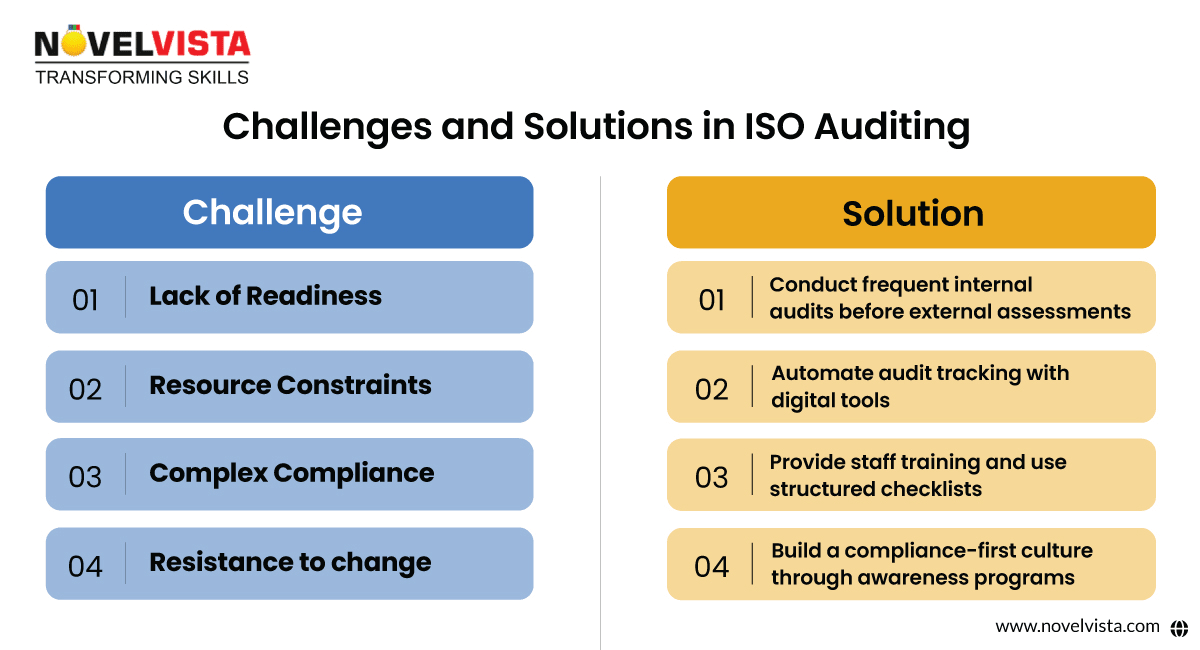
To dive deeper into common challenges, check out ISO Auditing: Challenges and Insights at NovelVista. Organizations may also struggle with challenges to implementing ISO 27001, which requires a proactive approach.
Best Practices for ISO Auditing in Healthcare, IT, and Manufacturing Sectors
For top-notch results in ISO audits, best practices are a must for IT, healthcare, and manufacturing firms. The first step?Fostering a quality-focussed, compliant culture across the entire company. All employees need to get involved in it.That means giving the right amount of resources and pushing for ongoing refinement. Next? Routine self-checks.These help spot potential improvement spots and non-conformities ahead of time. Teamwork and communication among all the departments and stakeholders? Non-negotiable. Effective ISO audits can’t happen without them.Lastly, don't view ISO audits as just a box to check for compliance. Instead, see them as learning opportunities for growth. Stick to these best measures, and reap the full benefits of ISO audits for ongoing improvement.
Common Challenges in ISO Auditing
ISO audits bring excellent benefits. Yet, certain obstacles may prevent them from yielding expected returns.
- Resources & Costs:ISO audits are large-scale and expensive. Employing competent labor and adequate facilities is vital. For struggling small businesses, budget restrictions may be a significant issue.
- Challenging Requirements:ISO's extensive and detailed guidelines may baffle company representatives attempting to fathom the standards properly. Intricate terms like risk-based considerations, confidence measures, and competence benchmarks can lead to confusion.
- Consistent Understanding:Variations in how standards are internalized by internal auditors compared to methods by external evaluators can alter results. Discrepancies like these might adversely affect an organization's perception of its complete ISO scheme.
- Job Volume:So, preparing for audits is heavy duty. There's document gathering, lining up talk times, itemizing tasks - all major energy drains. And don't forget the monster of identifying glitches using data study. It just chews up your hours and elbow grease.
- Maintenance:Post-ISO-approval, firms tend to chill out. Meaning, that they drop the ball until the next audit season. That laziness blows the real perks of auditing out of the water.
- Primitive Tech:Old-timey ways of storing data, like paper records, might stall an audit. Same goes for paper checklists or having no way to monitor online updates. These hiccups can slow down a clean, quick audit.
Overcoming these challenges is crucial, particularly for healthcare, IT, and manufacturing firms.They seek tangible advantages from implementing audit frameworks such as ISO. Essential steps involve educating personnel, procuring GRC applications, and aligning audits with business objectives.
Strategies for Streamlining ISO Auditing Practices
Easing ISO audit rules is simpler than you think. One great way is by creating dedicated teams.These teams handle the auditing procedures.They need to know their ISO stuff. Plus, they have to know how to audit and be able to make changes, if needed.Another tip? Use tech! Audit management software makes auditing way simpler by getting rid of repetitive tasks, keeping all necessary paperwork in one location, and helping auditors work together.But don't stop there. Always strive to be better. Running regular in-house audits and nipping any issues in the bud is key.By doing all this, any business can supercharge their ISO auditing skills and enjoy more success.
Technology Solutions for Efficient ISO Auditing
Tech helps with ISO audits. Tools present make work smooth and accurate.Things like audit management software do a lot. They automate tasks such as scheduling, handling documents, and report-making.This software lets auditors tidy up their workflow. It makes finding important files easy and report creation complete.Besides, frameworks can utilize data analytics tools. This inspects audit results, finds trends, and helps make sound decisions. It's all for better processes.What's more, cloud solutions amplify productivity. They let auditors in diverse locations work together in real-time. Taking up tech solutions allows firms to better their ISO audits. This leads to higher success.
Training and Education for ISO Auditors
ISO auditors need solid education and training. These folks have to learn many things to do great audits.Companies should invest in thorough training. The stuff they need to know includes ISO rules, how to do audits, and laws they have to follow. Training might be done by seasoned auditors or outside trainers.Also, auditors should keep learning to stay current with new industry stuff and top-notch ways of working.They can go to workshops, seminars, and conferences. Here, auditors learn more, share their experiences, and sharpen their audit skills. By putting education and training first, companies ensure their auditors can do excellent ISO audits.
Ready to Lead the Change in Auditing Excellence?
Gain the expertise to drive ISO compliance in your organization.
Conclusion
The rising importance of ISO standards in various sectors underscores the need for streamlined auditing. It's vital for organizations to reinforce their credibility, meet requisite compliance rules, and consistently improve.Health care, IT, and manufacturing industries have embraced ISO certification, seeing it as a marker of excellence rather than just a competitive edge.However, balancing international norms with specific industry regulations is complex.Enhancing audits demands a comprehensive strategy. It calls for leadership dedication, knowledge spread across all roles, appropriate resource allocation, and implementation of tech tools.By funding auditor education initiatives and supporting cloud-based audit tracking, quality assurance groups can boost efficiency to a great extent.Regular self-evaluations and continuous advancements need to be woven into the fabric of the organization's culture.Healthcare workers, tech pioneers, and factories are at the forefront of quality improvement.This makes our future look promising and enduring. This detailed ISO audit handbook is now available to guide them.It offers vital techniques and proven worldwide methods, essential for their upcoming growth phase.This handbook outlines essential principles. These principles help in building better healthcare networks, information systems, and supply chains that can outshine on the international level.
Author Details

Mr.Vikas Sharma
Principal Consultant
I am an Accredited ITIL, ITIL 4, ITIL 4 DITS, ITIL® 4 Strategic Leader, Certified SAFe Practice Consultant , SIAM Professional, PRINCE2 AGILE, Six Sigma Black Belt Trainer with more than 20 years of Industry experience. Working as SIAM consultant managing end-to-end accountability for the performance and delivery of IT services to the users and coordinating delivery, integration, and interoperability across multiple services and suppliers. Trained more than 10000+ participants under various ITSM, Agile & Project Management frameworks like ITIL, SAFe, SIAM, VeriSM, and PRINCE2, Scrum, DevOps, Cloud, etc.
Confused About Certification?
Get Free Consultation Call

